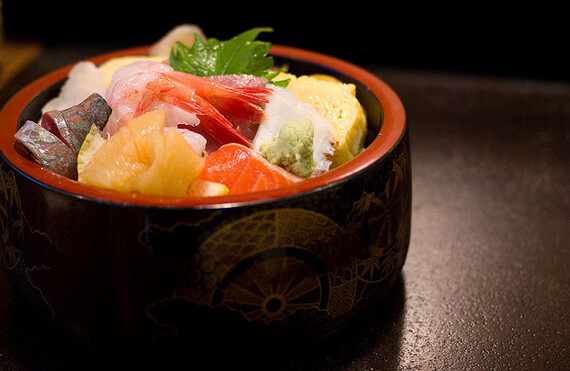Sasha, why did you choose to follow the sushi economy? Were you inspired by Pietra Rivoli's book on the travels of a t-shirt from cotton fields to the thrift store?
I think we have this idea that sushi is a product of ancient Japanese culture—the shoji screens and calligraphy scrolls behind the sushi bar are designed to lead us astray—but in fact it is the modern flows of goods, capital, people, and taste that makes the food possible.
I came to believe that I could show how globalization is lived by telling the story of how the global business and culture around sushi are sustained daily.
Pietra Rivoli's book was wonderful, and I think there are many similarities between what she did in her book and what I have done in mine, but one distinction is my focus on the development of appetites for sushi worldwide. One of the things I wanted to demonstrate was that the networks of supply and the networks that generate demand are often the same.
Is sushi really a Japanese invention?
Strictly speaking, sushi is Japanese: The nigirizushi (hand-pressed sushi) we eat today began as street snacks, sold by sidewalk vendors, in nineteenth-century Tokyo. But the culture of the sushi bar has more varied influences. For example, the Japanese didn't much care for tuna—or the idea of fatty red meat—until they saw Americans import beef during the post-war occupation and eat it as greasy steaks.
Now Japanese sushi culture revolves around tuna, usually the fattier the better. And it's trade that satisfies that appetite.
I trace the birth of modern sushi to the day in the summer of 1972 when Japan Air Lines carried four Canadian bluefin to Tokyo's Tsukiji market, the first time Atlantic fish had arrived in Japan by air. In a sense, contemporary sushi culture was born as much on the shores of Prince Edward Island as in any Japanese restaurant.
How does fish get from the ocean to a Japanese restaurant? How does sushi roll onto my dinner plate so to speak?
The path from sea to plate varies widely, depending on where you are, what you're eating, and what time of year. There are few products on earth that can lose as much value as quickly as seafood destined for the sushi bar, especially tuna. They are able to retain their value only because of the new infrastructure of globalization.
We wouldn't be eating sushi if not for cargo connections including transcontinental jets and super-frozen container ships, and the financial links that allow traders to continuously turn over deals across continents.
OK, I have to get this question out of the way, and you probably get this all the time. I know you are based in Philadelphia—what are your thoughts on the Philadelphia roll?
I don't terribly care for the texture of cream cheese in my sushi, but I want to offer something of a defense of the Philadelphia roll, and other innovations like it, by presenting a proper narrative of sushi's history. Sushi has always been changing, continuously in flux, under the influence of foreign tastes and international commerce.
Things like the Philadelphia roll that are dismissed as "inauthentic" often grew out of the same currents that produced the sushi items we prize as pure: The California roll has been eaten for about as long as toro nigiri (fatty tuna).
A sushi restaurant near my office in New York is Japanese-owned but the chefs are Chinese and the wait staff is Taiwanese. They train the chefs in Japan and send them to New York to work. It's like a Japanese cultural export with a supply chain in China. Is Japan increasingly exporting its cuisine, along with other cultural exports like anime and manga?
During the first wave of sushi restaurants around the world during the 1960s–1980s, it was common for young chefs working in Tokyo bars to ship off around the world to fill open jobs abroad. But now there are too many sushi bars for Japanese men to staff. Given that labor shortage, many sushi chefs in the U.S. today are not Japanese and not male.
It's common to see Chinese, Korean, Mexican, and native-born Americans cutting rice behind the bar—and, contrary to Japanese tradition, women, too. One tuna dealer at the Rungis market outside of Paris estimated to me that 85 percent of the proprietors of sushi bars in the Ile-de-France region were Vietnamese.
What's better: fresh or frozen?
These days, much of the global supply of tuna for sushi has been super frozen—in nitrogen-driven freezers as cold as -70°C—and at that temperature the fish is not supposed to experience any loss of color, texture, or flavor for up to two years. Ideally, you shouldn't have any idea if the fish you're eating has been moving through a multi-continent cold-storage supply chain for the last 18 months.
What are some of the environmental problems emerging from this trade?
The most urgent problem is one of overfishing. In my book, I focus on tuna. Largely worthless around the globe a generation ago, it is now one of the world's most contested—and with Tokyo chefs regularly paying $100 per pound for bluefin cuts—one of the most lucrative commodities.
International regulations and quota regimes haven't been able to keep up with the unsustainable disconnect between the limited supply and the seemingly unending demand.
Can you be an ethical diner and still eat fish?
Certainly the consumption of some fish comes with fewer environmental worries than others. But this is an exceptionally opaque supply chain. Fish do not travel with any documents about their provenance, and even many attentive, well-meaning chefs don't know which ocean the seafood they serve came from. That makes it difficult for the diner to enforce his ethics piece by piece at the sushi bar.
Enforcement of illegal fishing needs to take place at the time of the catch, and that is a job for government. Individuals who care about the future of oceans and wild fish stocks can be more effective as citizens than consumers—by putting pressure on governments to support tough quotas and catch restrictions, to aggressively impose that law on fishermen, ranchers, and dealers, and to push other countries to do the same.
So, what'll you be having—the chicken or the fish?
I'm sticking with the fish.
If the whole world developed a taste for sushi, what state would the oceans be in?
At this point, all eyes are on China. The luxury-minded Chinese middle classes are starting to develop an appetite for sushi, and just about everything—supply, prices, and pressure on wild stocks—will be determined by how quickly they take to the food and how quickly they develop the wealth to drive the market.
We've seen a version of this so far in Russia, Dubai, and elsewhere in East Asia: Consumption of sushi has turned out to be a pretty good indicator of full participation in the global economy. We've just never seen so large a population make that leap so quickly.
The future of sushi will likely take place in China. In a few years, you'll be asking me what I think of the Chengdu roll.






